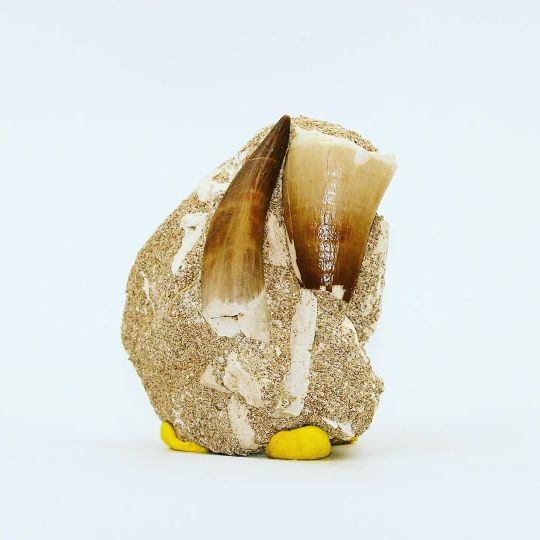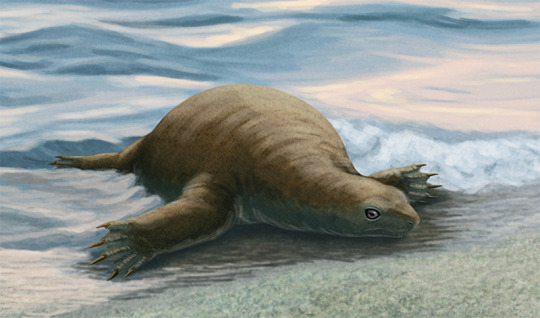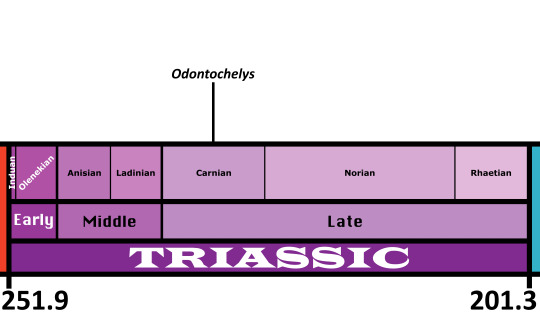#ammonite matrix fossil
Explore tagged Tumblr posts
Photo

BRADFORDIA LIOMPHALE Fossil Ammonite – Inferior Oolite, Jurassic Coast, Burton Bradstock, Dorset, UK
This listing features a beautifully preserved Bradfordia liomphale fossil ammonite discovered in the iconic Inferior Oolite strata of the Jurassic Coast at Burton Bradstock, Dorset, UK. This rare and scientifically notable ammonite dates back to the Middle Jurassic period and is an excellent example of the intricate shell structure and evolutionary significance of ammonites during this era.
Geological Unit: Inferior Oolite Group
Formation: Burton Bradstock Beds
Geological Period: Middle Jurassic
Stage: Early Bajocian
Biozone: Parkinsonia zone (based on locality association)
Depositional Environment: Shallow marine carbonate platform
Order: Ammonitida
Superfamily: Stephanoceratoidea
Family: Morphoceratidae
The specimen was carefully unearthed by our dedicated fossil hunters, Alister and Alison, on 17 January 2025. Following discovery, it was meticulously cleaned, stabilised, and prepped by Alison to highlight its ribbed pattern, detailed coiling, and preserved sutures.
Your fossil is set within a natural matrix from the site, retaining context from its original stratigraphic layer. A scale cube (1cm) is included in the photos for precise sizing—please refer to the image for complete dimensions. The photo represents the exact item you will receive.
All of our Fossils are 100% Genuine Specimens & come with a Certificate of Authenticity.
Whether you're an experienced fossil collector, a museum educator, or a geological enthusiast, this authentic ammonite fossil is a valuable and impressive addition to any collection.
#Bradfordia liomphale fossil#Jurassic ammonite#Burton Bradstock ammonite#Dorset fossil#ammonite UK fossil#certified ammonite#ammonite collector item#Inferior Oolite ammonite#fossil from Jurassic Coast#Mesozoic marine fossil#rare ammonite species#ammonite matrix fossil
0 notes
Text



Iridescent Ammonite on Matrix Placenticeras costatum Late Cretaceous (approx. 71 million years ago) Bearpaw Formation, Alberta, Canada
#Iridescent Ammonite on Matrix#Placenticeras costatum#Late Cretaceous#Bearpaw Formation#alberta canada#fossils#paleontologist#geologists#ancient artifacts#archeology#archeolgst#history#history news
90 notes
·
View notes
Text
New fossil additions.
I like to share for this little Fossil Friday, some pics of the newer fossils I brought from the lasts flea markets in the previous weekends.
The chalk rock corals were found or excavated collected from the Gosenkreide area from Austria.
White chalk like limestone with those nicely prevented pattern of the former polyps and corals skeleton here to seen.




Also along an new trilobite, and an ammonite nodule half in it’s rock matrix.
#fossil friday#fossilfriday#fossils#coral fossils#fossil collecting#geology#ammonite and others#fossils not in germany
2 notes
·
View notes
Note
Silly Game Time: Everyone is getting one crystal amulet on a necklace. Huzzah!
What color (and even type of crystal if you wish to be so precise) are you choosing? Is it simply a shard of crystal, or has it been sculpted into a shape of some kind?
Welcome to the world of birdy is obsessed with rocks even when they aren't shiny. I have a drawer full of crystals and pendant necklaces of various rocks. If I could get a new one, I'd either want a blue opal in matrix (polished up because the brown rock that's around them usually has a nice cherry red tint), a clear quartz chunk because I can tell people it's a kyber crystal, or another ammonite fossil filled in with lots of tiny rock pieces to make a rainbow (because I have one but would love a second).
But really, if someone gave me a crystal necklace I'd love it no matter what.
1 note
·
View note
Text
The Richest Fossil Limestone Hotspots for Finding Fossils

For fossil lovers, few joys compare to finding well-preserved specimens still encased within their original mineral matrix. Limestone formations dating back millions of years are one of the richest sources of diverse marine and terrestrial fossils spanning trilobites, ammonites, shark teeth and more. In this blog, we explore some of the most prolific fossil limestone sites across the world to find exciting fossil treasures. Read More: https://www.fossilageminerals.com/blogs/news/the-richest-fossil-limestone-hotspots-for-finding-fossils
0 notes
Photo

A nice association of a mosasaurus and a zarafasaurus teeth for sale. Specimens in matrix, finest quality. #fossils #fossil #paleontology #geology #dinosaurs #dinosaur #nature #science #fossilhunting #prehistoric #jurassicpark #jurassic #fossilhunter #jurassicworld #minerals #ammonite #rocks #fossiladdict #palaeontology #art #crystals #naturalhistory #ammonites #paleontologist #paleoart #megalodon #geologyrocks #trilobite #trilobites #cretaceous https://www.instagram.com/p/Cdv7gJjtvPf/?igshid=NGJjMDIxMWI=
#fossils#fossil#paleontology#geology#dinosaurs#dinosaur#nature#science#fossilhunting#prehistoric#jurassicpark#jurassic#fossilhunter#jurassicworld#minerals#ammonite#rocks#fossiladdict#palaeontology#art#crystals#naturalhistory#ammonites#paleontologist#paleoart#megalodon#geologyrocks#trilobite#trilobites#cretaceous
25 notes
·
View notes
Text
Item List 10-16-21
To claim an item please comment on the original item post and message me your info. The complete rules can be found here.
1. rose quartz fairies
2. lepidolite fairies
3. silver sheen obsidian fairies
4. pastel fluorite fairies
5. rainbow obsidian crescent moons
6. rainbow obsidian hearts
7. comb. moonstone & sunstone palm stones - Sold out!
8. comb. moonstone & sunstone spheres - Sold out!
9. comb. moonstone & sunstone hearts - Sold out!
10. rainbow fluorite detailed skulls
11. lilac fluorite mushrooms
12. dendritic fluorite points
13. dendritic fluorite mushrooms - Sold out!
14. dendritic fluorite freeforms
15. dendritic fluorite freeforms
16. carved and polished ammonite fossils
17. fibrous malachite clusters
18. sparkly high quality azurite on matrix
19. deep blue sodalite hearts
20. deep blue sodalite palm stones
21. star rose quartz spheres
22. pastel fluorite snakes
23. lepidolite raven skulls - Sold out!
24. phantom amethyst gems
25. phantom amethyst hearts
26. kunzite crescent moons and stars - Sold out!
27. aquamarine discs
28. aquamarine foxes
29. aquamarine spheres
30. labradorite ammonite carvings
31. labradorite roses - Sold out!
32. rhodochrosite cresent moons
33. clear quartz scepter points
34. labradorite butterflies
35. moss agate skulls
21 notes
·
View notes
Text
Odontochelys semitestacea

By @alphynix
Etymology: Toothed Turtle
First Described By: Lie et al., 2008
Classification: Biota, Archaea, Proteoarchaeota, Asgardarchaeota, Eukaryota, Neokaryota, Scotokaryota, Opimoda, Podiata, Amorphea, Obazoa, Opisthokonta, Holozoa, Filozoa, Choanozoa, Animalia, Eumetazoa, Parahoxozoa, Bilateria, Nephrozoa, Deuterostomia, Chordata, Olfactores, Vertebrata, Craniata, Gnathostomata, Eugnathostomata, Osteichthyes, Sarcopterygii, Rhipidistia, Tetrapodomorpha, Eotetrapodiformes, Elpistostegalia, Stegocephalia, Tetrapoda, Reptiliomorpha, Amniota, Sauropsida, Eureptilia, Romeriida, Diapsida, Neodiapsida, Sauria, Archosauromorpha?, Archelosauria, Pantestudines, Odontochelyidae
Time and Place: Around 232 million years ago, in the Carnian age of the Late Triassic

Odontochelys is known from the Lower Member of the Xiaowa Formation of China, commonly known as the Guanling Fauna

Physical Description: Odontochelys is one of the earliest known turtles - preceded by one, possibly two, precursors other than stem members of the family group - and it showcases how this extremely unique group managed to evolve in the chaos that was the Triassic Explosion. It was simultaneously similar to and very different from living turtles, a true transitional organism. Like other reptiles, it had teeth embedded in its jaws, rather than the toothless beak found in turtle mouths. Like turtles, it had the lower plastron extending from its ribs, but unlike living turtles it had no upper shell - instead, it just had widened ribs and no bony shell around its body. The ribs and the vertebrae were put together differently from modern turtles as well, and its skull was more stretched out compared to its living relatives. It didn’t have fused tail bones, and its scapulae were very different from living turtles. It had short limbs and long, thick fingers, as well as a decently sized shell. It was about forty centimeters long from snout to tail tip.
Diet: The diet of Odontochelys is fairly uncertain, despite us having its teeth; though they are small and peg like, we can’t really extrapolate a function since we don’t actually know its precise ecology! They may have been used for stripping plants, but it’s also possible they were used to chipp up algae and other aquatic water plants, or even invertebrates! So, more research there is clearly needed.
Behavior: The life history of Odontochelys is actually a big mystery. It was found in a marine environment, leading initial studies to indicate it was marine. However, it had the hands of a fresh water organism, including fresh water turtles today. Furthermore, studies of other early turtles indicate that turtles first arose on the land, rather than in the water, and later groups would adapt to water life; the limbs of Odontochelys share similarities with tortoises and support a terrestrial lifestyle. So, the ecology of Odontochelys has been a constant battle. That said, there is some evidence that it was actually marine - and may represent an early experiment in ocean life by turtles. One fossil of Odontochelys indicates that it had completely messed up shoulder bones, likely due to a problem in life rather than destruction of the fossil. This pattern resembles decompression sickness, aka the bends, aka the condition caused by a diving animal coming up much too fast from a lower depth. Modern turtles have complex behavioral adaptations to avoid the bends, so Odontochelys may be an early experiment in marine life in a group mostly adapted for terrestrial life. In this transition to ocean life, it not only lacked better physical adaptations for the ocean, but also better behavioral ones, and was stricken with the bends on its trip back to the surface. So, as we try to determine its ecology and behavior, these clued paint a rich tapestry of the world’s most transitional turtle. A pioneer!
Ecosystem: Odontochelys was found in - and thus, the null hypothesis is that it lived in - an ocean environment near the coast of the Tethys sea. This was a deep, open ocean - pelagic, hence the bends and problems Odontochelys faced trying to deal with the ocean. It was a very fertile ecosystem as well, with a variety of Triassic marine animals showcasing the rapid evolution of these groups. Among the invertebrates, there were many different types of Ammonites, plenty of bivalves, brachiopods, and crinoids & sea cucumbers as well. Still, the fascinating part of the ecosystem was the sheer number of marine reptiles. There were Thalattosaurs such as Anshusaurus and Xinpusaurus; Placodonts like Psephochelys and Sinocyamodus; and Ichthyosaurs like Qianicthyosaurus, Guizhouichthyosaurus, Guanlingsaurus, and Callawayia. One of many beautiful deposits of marine animals from this Period - and the many Ichthyosaurs would have been major predators of the relative n00b Odontochelys.
Other: Odontochelys also just looks really weird because it basically looks like your usual turtle except it doesn’t have a freaking shell so here we are with this oddity. It’s transitional in shape, transitional in ecology, transitional in behavior, and just. What the heck. What the heck, Odontochelys. If you need more proof for evolution despite knowing about the dinosaur - bird transition, have I got a friend for you.
~ By Meig Dickson
Sources Under the Cut
Anquetin, J. 2012. Reassessment of the phylogenetic interrelationships of basal turtles (Testudinata). Journal of Systematic Palaeontology 10(1):3-45.
Bradley Shaffer, H., E. McCartney-Melstad, T. J. Near, G. G. Mount, P. Q. Spinks. 2017. Phylogenomic analyses of 539 highly informative loci dates a fully resolved time tree for the major clades of living turtles (Testudines). Molecular Phylogenetics and Evolution 115: 7 - 15.
Feldmann, R. M., C. E. Schweitzer, S. Hu, J. Huang, Q. Zhang, C. Zhou, W. Wen, T. Xie, E. P. Maguire. 2017. A new Middle Triassic (Anisian) cyclidan crustacean from the Luoping Biota, Yunnan Province, China: morphologic and phylogenetic insights. Journal of Crustacean Biology 37 (4): 406 - 412.
Gilbert, S. F. 2007. How the turtle gets its shell. Biology of Turtles: The Structures to Strategies of Life.
Heiss, E. 2010. Functionality and plasticity of turtle-feeding with special emphasis on oropharyngeal structures. Universitat Wien Doctoral Dissertation.
Hess, H., W. Etter, and H. Hagdorn. 2016. Roveacrinida (Crinoidea) from Late Triassic (early Carnian) black shales of Southwest China. Swiss Journal of Paleontology 135(2):249-274.
Joyce, W. G. 2015. The origin of turtles: A paleontological perspective. Journal of Experimental Zoology Part B: Molecular and Developmental Evolution 324 (3): 181 - 193.
Lee, M. S. Y. 2013. Turtle origins: Insights from phylogenetic retrofitting and molecular scaffolds. Journal of Evolutionary Biology 26 (12): 2729 - 2738.
Lemell, P., N. Natchev, C. J. Beisser, E. Heiss. 2019. Feeding in Turtles: Understanding Terrestrial and Aquatic Feeding in a Diverse but Monophyletic Group. Feeding in Vertebrates: 611 - 642.
Li, C., and O. Rieppel. 2002. A new cyamodontid placodont from Triassic of Guizhou, China. Chinese Science Bulletin 47(5):403-407.
Li, C., X. C. Wu, O. Rieppel, L. T. Wang, and L. J. Zhao. 2008. An ancestral turtle from the Late Triassic of southwestern China. Nature 456:497-501.
Lu, H., D.-Y. Jiang, R. Motani, P.-G. Ni, Z.-Y. Sun, A. Tintori, S.-Z. Xiao, M. Zhou, C. Ji, W.-L. Fu. 2018. Middle Triassic Xingyi Fauna: Showing turnover of marine reptiles from coastal to oceanic environments. Palaeoworld 27 (1): 107 - 116.
Luo, M., Y.-M. Gong, G. R. Shi, Z.-Q. Chen, J. Huang, S. Hu, X. Feng, Q. Zhang, C. Zhou, W. Wen. 2018. Palaeoecological Analysis of Trace Fossil Sinusichnus sinuosus from the Middle Triassic Guanling Formationin Southwestern China. Journal of Earth Science 29: 854 - 863.
Meredith, R. W., J. Gatesy, M. S. Springer. Molecular decay of enamel matrix protein genes in turtles and other edentulous amniotes. BMC Evolutionary Biology 13: 20.
Neenan, J. M., N. Klein, T. M. Scheyer. 2013. European origin of placodont marine reptiles and the evolution of crushing dentition in Placodontia. Nature Communications 4: 1621.
Nicholls, E. L., C. Wei, and M. Manabe. 2002. New material of Qianichthyosaurus Li, 1999 (Reptilia, Ichthyosauria) from the Late Triassic of southern China, and implications for the distribution of Triassic icthyosaurs. Journal of Vertebrate Paleontology 22(4):759-765.
Reisz, R. R., J. J. Head. 2008. Palaeontology: Turtle origins out to sea. Nature 456 (7221): 450 - 451.
Rothschild, B. M., V. Naples. 2015. Decompression syndrome and diving behavior in Odontochelys, the first turtle. Acta Palaeontologica Polonica 60 (1): 163 - 167.
Schoch, R. R., H.-D. Sues. 2015. A Middle Triassic stem-turtle and the evolution of the turtle body plan. Nature 523 (7562): 584 - 587.
Shang, Q.-H., and C. Li. 2009. On the occurrence of the ichthyosaur Shastasaurus in the Guanling biota (Late Triassic), Guizhou, China. Vertebrata PalAsiatica 47(3):178-193.
Vermeij, G. J., R. Motani. 2017. Land to sea transitions in vertebrates: the dynamics of colonization. Paleobiology 44 (2): 237 - 250.
Wang, X., G. H. Bachmann, H. Hagdorn, P. M. Sanders, G. Cuny, X. Chen, C. Wang, L. Chen, L. Cheng, F. Meng, and G. Xu. 2008. The Late Triassic black shales of the Guanling area, Guizhou province, south-west China: a unique marine reptile and pelagic crinoid fossil lagerstätte. Palaeontology 51(1):27-61.
Wang, X., X. Chen, C. Wang, L. Cheng. 2009. The Triassic Guanling Fossil Group - A Key GeoPark from a barren mountain, Guizhou Province, China. Notebooks on Geology 3: Chapter 2: 11 - 28.
328 notes
·
View notes
Text
More rocks!
Click through for more shiny things!
See post 1 here.










Beryl (var. Emerald).
Selenite.
Zincite.
Ammonite fossil.
Garnet (var. Pyrope).
Smithsonite.
Chalcedony.
Fluorite with Barite.
Sulphur.
Cavansite on Stilbite/Apophyllite matrix.
6 notes
·
View notes
Photo

Fossil Goniatite in Matrix – Devonian Period, Erfoud Morocco, Authentic Prehistoric Specimen
A stunning and authentic Fossil Goniatite preserved in its original limestone matrix, dating to the Devonian Period, approximately 390–400 million years ago. This specimen comes from the Erfoud region of Morocco, an area renowned for its rich fossil beds and well-preserved marine invertebrates.
Goniatites are extinct ammonoid cephalopods, ancestral relatives of modern squids and octopuses. They are characterised by their tightly coiled, planispiral shells and simpler suture patterns compared to later ammonites. This fossil offers excellent detail of the shell's spiral and internal chamber structure.
Fossil Type: Ammonoid Cephalopod (Goniatite)
Geological Age: Devonian – Middle to Late Devonian (Givetian-Frasnian)
Formation: Likely Maïder Basin marine limestone beds near Erfoud
Depositional Environment: These goniatites lived in warm, shallow marine environments of the ancient Paleozoic seas. After death, their shells settled into fine carbonate sediments that later lithified into limestone. The conditions allowed for excellent preservation of both external and internal shell structures.
Morphological Features:
Tightly coiled spiral shell (planispiral)
Distinct chamber divisions (septa)
Suture lines typically simple and curved (goniatitic)
Presented in limestone matrix, sometimes with associated fauna
Notable:
Classic example of early ammonoid evolution
Attractive fossil suitable for display or study
Collected from Morocco’s famous Devonian fossil beds
Photo shows the exact item you will receive
Authenticity: All of our fossils are 100% genuine natural specimens and come with a Certificate of Authenticity. Please refer to the scale image for sizing – each square or cube represents 1cm.
This Devonian Goniatite fossil from Morocco is a beautifully preserved relic of Earth’s ancient oceans and an excellent addition to any fossil collection or educational setting.
#Goniatite fossil#Devonian fossil Morocco#fossil cephalopod#Erfoud fossil#matrix fossil#goniatite ammonoid#prehistoric marine fossil#fossil spiral shell#Morocco fossil specimen#genuine goniatite#collector fossil ammonite#orthoceras and goniatite#fossil display plate
0 notes
Text
Golden fossils reveal origins of exceptional preservation
A recent study by scientists at The University of Texas at Austin and collaborators found that many of the fossils from Germany’s Posidonia shale do not get their gleam from pyrite, commonly known as fool’s gold, which was long thought to be the source of the shine. Instead, the golden hue is from a mix of minerals that hints at the conditions in which the fossils formed. The discovery is important for understanding how the fossils — which are among the world’s best-preserved specimens of sea life from the Early Jurassic — came to form in the first place, and the role that oxygen in the environment had in their formation. “When you go to the quarries, golden ammonites peek out from black shale slabs,” said study co-author Rowan Martindale, an associate professor at the UT Jackson School of Geosciences. “But surprisingly, we struggled to find pyrite in the fossils. Even the fossils that looked golden, are preserved as phosphate minerals with yellow calcite. This dramatically changes our view of this famous fossil deposit.” The research was published in Earth Science Reviews. Drew Muscente, a former assistant professor at Cornell College and former Jackson School postdoctoral researcher, led the study. The fossils of the Posidonia Shale date back to 183 million years ago, and include rare soft-bodied specimens such as ichthyosaur embryos, squids with ink-sacs, and lobsters. To learn more about the fossilization conditions that led to such exquisite preservation, the researchers put dozens of samples under scanning electron microscopes to study their chemical composition. “I couldn’t wait to get them in my microscope and help tell their preservational story,” said co-author Jim Schiffbauer, an associate professor at the University of Missouri Department of Geological Sciences, who handled some of the larger samples. The researchers found that in every instance, the fossils were primarily made up of phosphate minerals even though the surrounding black shale rock was dotted with microscopic clusters of pyrite crystals, called framboids. “I spent days looking for the framboids on the fossil,” said co-author Sinjini Sinha, a doctoral student at the Jackson School. “For some of the specimens, I counted 800 framboids on the matrix while there was maybe three or four on the fossils.” The fact that pyrite and phosphate are found in different places on the specimens is important because it reveals key details about the fossilization environment. Pyrite forms in anoxic (without oxygen) environments, but phosphate minerals need oxygen. The research suggests that although an anoxic seafloor sets the stage for fossilization — keeping decay and predators at bay — it took a pulse of oxygen to drive the chemical reactions needed for fossilization. These findings complement earlier research carried out by the team on the geochemical conditions of sites known for their caches of exceptionally preserved fossils, called konservat-lagerstätten. However, the results of these studies contradict long-standing theories about the conditions needed for exceptional fossil preservation in the Posidonia. “It’s been thought for a long time that the anoxia causes the exceptional preservation, but it doesn’t directly help,” said Sinha. “It helps with making the environment conducive to faster fossilization, which leads to the preservation, but it’s oxygenation that’s enhancing preservation.” It turns out, the oxygenation — and the phosphate and accompanying minerals — also enhanced the fossil’s shine. The research was funded by Cornell College and the National Science Foundation. The Posidonia fossil specimens used in this study are now part of the collections at the Jackson School’s Non-Vertebrate Paleontology Laboratory.
0 notes
Photo



Ammonite Fossil on matrix (Upper Cretaceous) - Bearpaw Formation, Alberta, Canada
2K notes
·
View notes
Video
yorkshire.fossils This is another look at one of our favourite ammonites, prior to the outer matrix being polished, for those who haven't seen it. These 'Cannon ball' nodules (rocks) are thought to be exclusive to the Yorkshire Coast, found nowhere else in the world. They rarely contain fossils, but when they do, they typically contain an Eleganticeras sp. ammonite. This fossil here is featured as found. Some of the outer chambers were broken open when we cracked open this rock, which allowed a rich smell of bituminous oil to be released.
#Ammonite#cannon ball#geology#mineral#crystal#fossil#fossilfriday#jurassic coast#yorkshire#video#rock#limestone#the earth story#instagram
4K notes
·
View notes
Photo

Top rare Prognathodon giganteus tooth in matrix for sale. A well preserved specimen without restorations. #fossils #fossil #paleontology #geology #dinosaurs #dinosaur #nature #science #fossilhunting #prehistoric #jurassicpark #jurassic #fossilhunter #jurassicworld #minerals #ammonite #rocks #fossiladdict #palaeontology #art #crystals #naturalhistory #ammonites #paleontologist #paleoart #megalodon #geologyrocks #trilobite #trilobites #cretaceous https://www.instagram.com/p/CeHbwncN_ys/?igshid=NGJjMDIxMWI=
#fossils#fossil#paleontology#geology#dinosaurs#dinosaur#nature#science#fossilhunting#prehistoric#jurassicpark#jurassic#fossilhunter#jurassicworld#minerals#ammonite#rocks#fossiladdict#palaeontology#art#crystals#naturalhistory#ammonites#paleontologist#paleoart#megalodon#geologyrocks#trilobite#trilobites#cretaceous
0 notes
Video
Ammonite Nacre Squared by cobalt123 Via Flickr: Ammonite Nacre Squared - Straight on view of a very large ammonite fossil prepared for Canada Fossils/John Issa. Seen at the Tucson City Center venue of the Tucson Gem and Mineral Show. This piece measures about 18” diameter within the large matrix.
#ammolite#2 foot diameter#2018#Canada Fossils#February 3#John Issa#Tucson City Center#Tucson Gem and Mineral Show#ammonite#crystal#crystal form#fossil#iridescent#mineral#nacre#outdoors#rock#shale#specimen
2 notes
·
View notes
Photo






Lituites Carved Elongated Mayan Alien Crystal Skull
Lituites fossils like this are from an extinct nautiloid genus from the Middle Ordovician period, about 458 to 470 million years ago, about the same time land plants appeared. By the time the first ammonites appear in the fossil record, about 400 million years ago, the lituites genus had come and gone. As juveniles, lituites had coiled shells, however when reaching adulthood they continued their growth in a mostly straightened direction. The adult animal was considered to occupy part of the coiled section of the shell as well as the entire portion of the straight length of the shell. Whereas the ammonites were more closely related to modern octopi, cuttlefish, and squid, the lituites genus members were in the nautiloid subclass, and the modern six living species of nautilus are the only surviving close relatives of these long gone fossils. It is speculated that the lituites inhabited shallow water areas of the ocean.
Here a lengthy fossil specimen lends itself perfectly to our elongated, Mayan, alien crystal skull design. A rich brown matrix of fossilized seabed is polished to a glossy finish beneath a beautifully displayed lituites fossil. Deep eye sockets and intricately detailed teeth balance the natural spiral at the other end of the sculpture. A stunning variation on this already fascinating crystal skull design, this single piece sculpture is carved from a solid specimen from Madagascar. Measuring 5.2x1.7x2.0 inches (132x42x49 mm) and weighing 12.1 ounces (343 g). Visit Skullis.com to see all the pictures and information about this beautiful lituites fossil crystal skull sculpture.
1 note
·
View note
